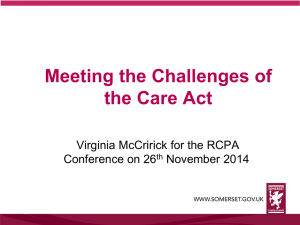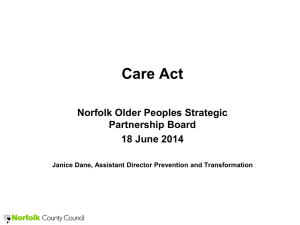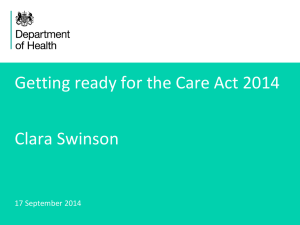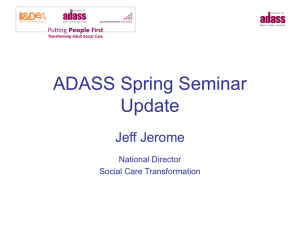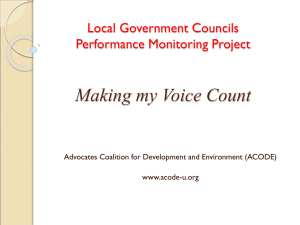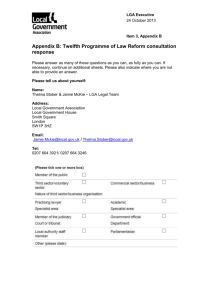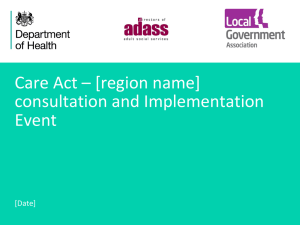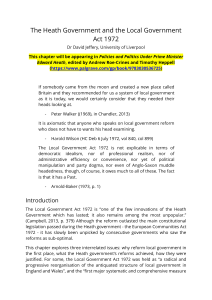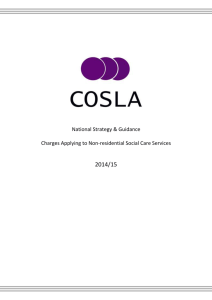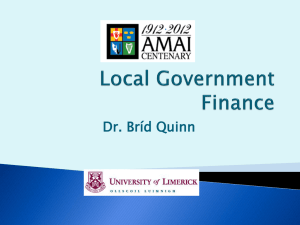Care act implementation and risk
advertisement
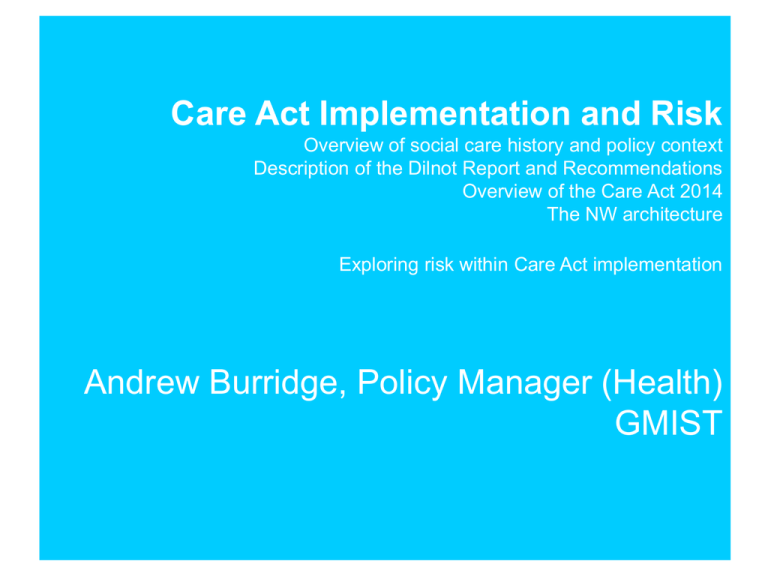
Care Act Implementation and Risk Overview of social care history and policy context Description of the Dilnot Report and Recommendations Overview of the Care Act 2014 The NW architecture Exploring risk within Care Act implementation Andrew Burridge, Policy Manager (Health) GMIST Complex legal framework • • • • • • • • • • • 1960s – series of scandals based around large psychiatric institution see a move to community based care Local Authority Social Services Act (1970) – establishing social services committees, the formal role of Director, and the need to act under the general direction of the Secretary of State. Chronically Sick and Disabled Persons Act (1970) – introduced a duty on the LA to assess the individual needs of adults who met the criteria within the National Assistance Act Disabled Persons Act 1986 – enabled individuals and carers to request an assessment. Social Security Act 1986 – replaced Supplementary Support with Income Support, with a tighter financial criteria. 1988 Independent Living Fund introduced – small direct payments to people with severely disability and low incomes NHS and Community Care Act 1990 – established the duty to provide a service if needs are established as eligible. New arrangements for assessment and care management and individuals receiving individual tailored packages of care. As long stay hospitals closed an assumption that people will receive care in their own homes. Community Care and Direct Payments Act 1996 – local authorities enabled to provide cash payments to people rather than provide a service. Health and Social Care Act 2001 – mandatory to provide direct payments Health and Social Care Act 2008 Health and Social Care Act 2012 Policy trends Increasing focus upon well-being and prevention Assumption of a person’s ability, rather than disability People receiving care seen as individuals with unique needs Local authorities to become commissioners of care, rather than providers. Increasing use of direct payments and personalisation Social workers to take on roles of assessment and care management Diverse market of providers developing – private and third sector Financial pressures Councils are facing significant and increasing demand and financial pressure. Adult social care spending has fallen by c8.5% in real terms from 2011/12 to end of 2013/14 • (2013/14 prices) • • • • Since 2011/12 central revenue support for councils has reduced by c10% each year (c39% by end of 2014/15). This is equivalent to a reduction in spending power of c4-5%. Impact varies locally – some councils have seen spending power reduce by c7% each year. Many councils have still given relative protection to ASC compared to some other services. Overall councils have reduced spending on ASC by c8.5% in real terms over three years to end 2013/14, consistent with 3% national efficiency assumption. User numbers have also reduced significantly over the SR period, particularly for +65s: • • • 19% fewer over-65s receiving community care 2% fewer over-65s receiving residential/nursing care Reported outcomes and satisfaction have remained stable, but data limited to people receiving care. Overall councils have delivered savings whilst maintaining outcomes and satisfaction levels. Within ten years local authority revenue budgets will be entirely taken up by Adult SC expenditure, children’s services, and Council Tax Benefit Background to the Dilnot Recommendations 1. The current adult social care funding system in England is not fit for purpose and needs urgent and lasting reform. 2. The current system is confusing, unfair and unsustainable. People are unable to plan ahead to meet their future care needs. 3. A major problem is that people are unable to protect themselves against very high care costs. 4. Most people are realistic about the need for individuals to make some contribution to the costs of care in later life, but they want a fairer way of sharing costs and responsibility between the state and individuals and they want to be relieved of fear and worry. There is consensus on the need for reform. 5. To support a strategic and cultural shift in care and support towards wellbeing and prevention. Background to the Dilnot Recommendations 1. The current adult social care funding system in England is not fit for purpose and needs urgent and lasting reform. 2. The current system is confusing, unfair and unsustainable. People are unable to plan ahead to meet their future care needs. 3. A major problem is that people are unable to protect themselves against very high care costs. 4. Most people are realistic about the need for individuals to make some contribution to the costs of care in later life, but they want a fairer way of sharing costs and responsibility between the state and individuals and they want to be relieved of fear and worry. There is consensus on the need for reform. 5. To support a strategic and cultural shift in care and support towards wellbeing and prevention. Dilnot Recommendation (2011) Care Act (2014) Cap lifetime contributions towards their social care costs should be capped at £35,000 Cap set at £72,000 from April 2016 and lower for working age adults. Requires the introduction of Care Accounts. People should contribute a standard amount to cover their general living costs, such as food and accommodation, in residential care - We believe a figure in the range of £7,000 to £10,000 a year A standard contribution to living costs of around £12,000 a year will be set from April 2016 – this will not count towards the cap. The means tested threshold should be increased from £23,250 to £100,000 The threshold for support is increased to £118,000 in assets (including their home). People should not have to immediately sell their homes and therefore to introduce a national deferred payment scheme. People will the option to defer paying care home fees from April 2015, so that people do not have to sell their home in their lifetime to pay for residential care National eligibility and portable assessments Introduced To encourage people to plan in later life the Government needs to plan a major communications campaign and introduce an information and advice strategy in partnership with the financial sector. Public Health England to support local comms and a national strategy in 15/16 Unclear picture regarding financial products Care Act 2014:Headline reform on social care funding and support • • Places well-being, and outcomes, is at the centre of every decision Focus on prevention and delaying needs, and integration and partnership working is reinforced • Provides a single framework for social care addressing: – – – – – – – – – – – – • Assessment (extending rights to self-funders) Carers Charging and financial assessment Advocacy Person centred care and support planning Adult safeguarding Integration and partnership working Moving between areas (portability) and transitions Delegating functions (third party assessments) Prisons Sight registers (visual impairment) Managing provider failure Presentation attempts to focus upon those areas with the most pressing risks. Summer – Autumn 2013 2013 – 2014 April 2015 April 2016 • Formal consultation. • Establish a partnership between Department of Health, LGA and ADASS and work together on detailed implementation plans to ensure effective preparation for and implementation of reforms. • Government response to the consultation setting out more detailed plans. • Continued engagement with local authorities, providers, voluntary and community sector, financial services organisations and individuals and carers on details including regulations and guidance. • May 2014 Care Bill granted Royal Assent • Introduction of a range of duties around assessment, charging, care planning and review • Introduction of deferred payments and preparation for introduction of cap using the £335m allocated in the Spending Review. • National minimum eligibility standard and fairer charging framework. • Introduction of cap on care costs, care accounts and extended access to financial support. • An expectation that local authorities organise early assessments for self funders from November 2015 Northwest Task & Finish Group • Stuart Cowley (Director, Wigan Council) agreed to act as lead DAS. • Representatives from all NW local authorities with links to NHS England. The Group is: • Identifying the workstreams required to successfully implement the Bill. • Allocating tasks across the collective NW resource, and creating new architecture where necessary. • Agreeing use of regional funding allocations. • Championing Northwest analysis and exploring lobbying opportunities. • Communicating across NW ADASS. Risk assessment • Suggestions taken from: – NW Task & Finish Group – NW Finances and Resources Group (developed a submission into the National Finance Group) – Local risk registers Assessment and eligibility • A new framework for assessment and eligibility – based around wellbeing. – A shift from duties to provide particular services, to the concept of ‘meeting need’. – A requirement to consider prevention and independent living (pre-formal assessment). – Implications for local policy and capacity. • New right for carers to request an assessment. • A national eligibility criteria. Concern that the wording of the legislation extends thresholds into ‘moderate’, not the ‘substantial’ levels that most NW Councils have set. • Risks relating to consultation, process design, staff training, increased costs to the local authority, availability of workforce. Charging and financial assessment • • • • • • • • • • • • A new duty to provide an assessment to all people, regardless of finances or whether the LA thinks they will be eligible. Self funders will have a right to ask the local authority to arrange their care for them. From April 2016 the local authority will need to maintain a Care Account for anyone that asks for one. Local authorities can currently charge for services. We retain the discretion to decide when to charge. We will be allowed to charge admin fees to self funders when we arrange their care. Local authority will be allowed to carry out ‘light touch financial assessments’ where thinks this is appropriate. We will need clear policies for charging, charging self-funders administration fees, and charging carers and Deferred Payment Agreements – local consultation required? If we want to carry out 'light touch assessments' – local policy needs to be agreed, unanswered questions about proportionality and financial risk. Increased requirement for financial assessments based on numbers of self funders. New financial tools and training implications arising from Care Accounts and Deferred Payment Agreements. Risk around allowing rental income for properties that have a DPA. Financial context places increased pressure upon the local authority to recoup costs. Ongoing potential for legal challenge – legal literacy training to follow. Increased activity and financial risk • Two national models are being used to identify costs. – – – – – – Lincolnshire Model (15/16) Surrey Model (16/17 and beyond) Lincolnshire model not yet reported. Surrey Model is still not sufficiently robust to produce aggregated results. National collection of local data and results postponed until January/February 2015 Joint ADASS/DoH/LGA advice for forward financial planning is that the costs of funding reform will be fully funded. Extremely important that we influence and secure appropriate funding of the reforms • Understanding the number of self funders is extremely hard 0 120-180k? • There is also a similar but different gap regarding carers - and how many additional assessments and support will be required as a consequence of the Care Act proposals. 350k 720k? • How can we workforce plan and design processes effectively without making assumptions? Personalised care and support planning • Local authorities will have to provide individual support plans and personal budgets. • Individuals will have strengthened rights to ask for direct payments. • The Local Authority must not stifle choice and innovation. • The Local Authority must be satisfied that the direct payment is being used to meet eligible care and support needs. • Direct payments raise questions about fraud and error. 2012 Audit Commission report looked at 102 cases totalling £2.2m. • Reputational risks around the choices that services users make. • Financial safeguards and political sensitivities need to be balanced against transforming people’s lives by giving them control. Workforce • These changes have major implications for the social care workforce. – Staff across the social care and health sector may not have the understanding to do the job under the new legislation – Capacity of staff to deal with new / additional demand driven by Care Act – Impact of local restructure and authority wide financial pressure mean management and leadership around Care Act implementation lose focus It is important that Councils look to manage down this risk as far as possible: – New joined up approaches to assessment – ‘Proportionate or light touch’ assessment – Third party assessment • Some Councils are looking at workforce redesign so that higher paid qualified social workers quality on DOLS, BIA, Continuing Healthcare and complex multiagency working. – • • Process mapping has identified a range of simple ‘admin’ functions that unqualified social workers can carry out. NW Group looking at commissioning training at the NW or sub-regional level, and focused work looking at the potential for ‘social care officer’ roles. Financial risks and the costs of training, and implementation risks around scheduling training and identifying the appropriate providers. Market shaping • A duty to support a market for adult social care that delivers a wide range of care and support services. • Risk of upward pressure on market fees in residential and nursing care – particularly the ‘top-up’ subsidy issue. • From April 2015 – the right of a self funder to request LA support in arranging for needs to be met is likely to see transfer of private payers to lower local authority fee levels. • Duties on local authority to manage provider failure. Local authorities would ultimately already by likely to step in and should have contingency plans. The threshold is for large providers (1000+ beds) so large rural counties might need closer relationships with small providers. Safeguarding Adults • A clear legal framework for how LAs should protect vulnerable adults – requirements for Adult Safeguarding Boards. • Systems should already be in place – not featuring as a major risk, but could see increased referrals. • Advised that auditors need to be included in safeguarding reviews. Strategic risks • Political and reputational – Government creates unrealistic and unaffordable expectations of the offer available from local councils, and the gap between expectations and reality impacts on local citizens views of the county council. – Other government reform programmes (eg Pensions, prisons, welfare reform) make Care Act preparation and implementation hard to deliver effectively. – Failure to deliver major elements of the requirements of the Care Act. • Legal – Litigation from individuals or groups dissatisfied with offer or process. • Financial – Magnitude of gap between Government funding and local expenditure related to the Care Act is uncertain and / or significant. • Care Act ICT – Systems changes are not delivered in time (Care Accounts / Deferred Payments). • Partnership / relationship management – Care Act implementation divorced from Better Care Fund and wider strategic integration agenda. • Project governance – Project management and leadership capacity to deliver. – Insufficient understanding of interdependencies and risks associated with other. projects not hitting key milestones Local risk registers? Recommendations / implications for audit • Be aware of the Act and understand who the local Care Act lead is • Explore involvement in local programme management teams • Support the development of local risk registers • Representation on the NW Care Act Task & Finish Group Contacts • a.burridge@agma.gov.uk • http://www.local.gov.uk/care-supportreform • Care and Support statutory guidance (June 2014): https://www.gov.uk/government/uploads/s ystem/uploads/attachment_data/file/31599 3/Care-Act-Guidance.pdf

